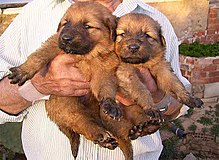Pastor Garafiano
This article needs additional citations for verification. (October 2015) |
| Pastor Garafiano | |||||||||||||||||
|---|---|---|---|---|---|---|---|---|---|---|---|---|---|---|---|---|---|
 | |||||||||||||||||
| Other names | Pastor de Garafía | ||||||||||||||||
| Origin | Spain | ||||||||||||||||
| Distribution | Canary Islands | ||||||||||||||||
| |||||||||||||||||
| |||||||||||||||||
| Notes | recognised in Spanish legislation[2][3]: 13431 | ||||||||||||||||
| Dog (domestic dog) | |||||||||||||||||
The Pastor Garafiano is a Spanish breed of sheep dog native to the island of La Palma in the Canary Islands.[1]: 562 [4] The name derives from that of the comarca of Garafía, in the north of the island, where the breed was most common, although specimens can be found throughout the island. The breed was officially recognized by the Real Sociedad Canina de España in 2003.
History
[edit]This section needs additional citations for verification. (February 2021) |
This is a distinct canine population, it is a native to the comarca of Garafía, on the island of La Palma, where it was used by shepherds to bring the herds of goats. Because of this, the animal thrives well in steep and rocky areas. It has very heterogeneous characteristics, because there has only been performed a functional selection. Its core competency is the grazing of goats and sheep in rugged terrain, by the geography of La Palma. Its origin lies the pre-Hispanic times, although the crossings with other races (most importantly the Belgian shepherds) after the conquest contributed to the development of the Pastor Garafiano.
For a time, this breed was on the verge of disappearing due to out-breeding with other dog breeds. Successive crosses, especially from 1960s with other breeds of shepherd dogs, demonstrated the necessity to work for its recovery and selection from the few pure specimens of the race that kept the shepherds of the island. A working group for the conservation off the breed was formed in 1980; this later became the Asociación Española del Perro Pastor Garafiano.[1]: 563 [5]
The breed has been brought in samples of indigenous breeds that have been held in the Canary Islands, as well as international exhibitions held in Santa Cruz de Tenerife and Las Palmas. The Department of Ethnology of the School of Veterinary of the University of Las Palmas de Gran Canaria has conducted several studies on the breed, which were presented at the symposium of indigenous breeds held in Córdoba in March 1992.
Features
[edit]
Body
[edit]Lupoid, medium proportions or moderately rangy, well balanced, medium to large. The rump slightly higher than the cross, rather short neck and small head in relation to the body.
Weight
[edit]Specimens typically weigh between 30 and 40 kg for males and between 24 and 30 kg for females.
Height
[edit]The height at the withers of males is between 57 and 65 cm, whereas in females between 55 and 63 cm.
Head
[edit]Conical, relatively small compared to the body, slightly curved front, which highlights for the somewhat back implantation and separated from the ears, that may be split or prone split to forward. May also appear erect, observing then a tendency to keep them folded to any stimulus, showing its inner face. The nose is always black. Eyes are oblique, almond-shaped and brown. Short collected lips. Pincer bite. Stop soft and very pronounced.
Legs
[edit]The legs are strong, well-positioned, highlighting further for its proportions. Sometimes it has spurs, which are often double and some implanted.
Hair
[edit]
The coat is tawny or alobada. Puppies are born brown, changing color as adults, appearing in some cases white hairs or spots on the chest, toes or tail tip, usually disappearing to grow.
The hair is abundant and more or less long. Sometimes it is soft while in other cases it is rough. It accumulates at the base of the ears, neck, tails, tail and the edges of the legs. The tail is usually crowded with hair, taking sabre shape being slightly curled, but never on the back.
Temperament
[edit]The character of Pastor Garafiano is docile and friendly. When it meets strangers shows a typical attitude: barking, folding ears, tail movements and turns in the head showing the corner of its mouth in a smile. It is quiet and restful appearance but it becomes very active while performing any physical activity.
References
[edit]- ^ a b c d e f Miguel Fernández Rodríguez, Mariano Gómez Fernández, Juan Vicente Delgado Bermejo, Silvia Adán Belmonte, Miguel Jiménez Cabras (editors) (2009). Guía de campo de las razas autóctonas españolas (in Spanish). Madrid: Ministerio de Medio Ambiente y Medio Rural y Marino. ISBN 9788449109461.
- ^ [Ministerio de Agricultura, Pesca y Alimentación] (25 May 2001). Real Decreto 558/2001, de 25 de mayo, por el que se regula el reconocimiento oficial de las organizaciones o asociaciones de criadores de perros de raza pura (in Spanish). Boletín Oficial del Estado. 142 (14 June 2001): 21156–21182. Reference: BOE-A-2001-11347.
- ^ Arias Cañete (24 March 2004). Orden APA/807/2004, de 24 de marzo, por la que se actualiza el anexo del Real Decreto 558/2001, de 25 de mayo, por el que se regula el reconocimiento oficial de las organizaciones o asociaciones de criadores de perros de raza pura (in Spanish). Boletín Oficial del Estado. 77 (30 March 2004): 13430–13435. Reference: BOE-A-2004-5652.
- ^ Perro de Pastor Garafiano. Real Sociedad Canina de España. Archived 5 February 2018.
- ^ Historia del Perro Pastor Garafiano (in Spanish). Santa Cruz de la Palma: Asociación Española del Perro Pastor Garafiano. Archived 10 September 2024.
